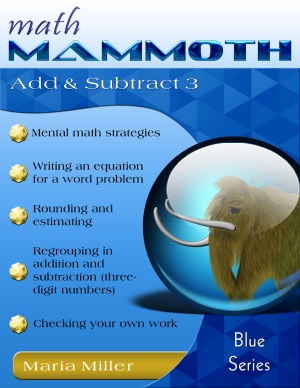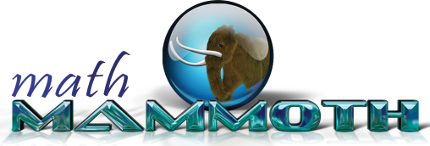Math Mammoth Add & Subtract 3

93 pages
(includes answers)
Sample pages (PDF)
Contents
Mental Addition
Concept of Difference
Rounding to the Nearest Ten, Part 2
Regrouping with Zero Tens
Prices & ordering
PDF download USD $7.90
You will be purchasing the downloads from my authorized reseller Comecero, LLC.
Printed copy $10.50
Printed copy £7.20, full color
US shipping available
 Este libro en español
Este libro en español
Math Mammoth Add and Subtract 3 focuses on addition and subtraction, both with mental math and in columns, in about 3rd grade level. The book assumes the student has learned to add both two- and three-digit numbers with regrouping, to subtract two-digit numbers with regrouping, and to subtract three-digit numbers when there is a maximum of one regrouping. (The book deals with regrouping twice in subtraction and regrouping over zero tens but does not teach in detail regrouping in subtraction when there is only one regrouping involved. That topic is taught in Math Mammoth Add & Subtract 2-C.)
The first part of the book (through the lesson Review 1) focuses on mental math, word problems, and patterns. The beginning lessons give a review of basic addition and subtraction facts, plus a review of some mental math strategies on a second grade level, so that even students who perhaps did not study mental math in earlier grades can catch up.
Then, students practice writing an equation with an unknown for two-step word problems. In this book, the problems include only additions and subtractions. Students continue with this topic later in third grade, and in fourth grade when they work on multi-step word problems in the same manner. Their work here is foundational to writing equations to solve problems and to model situations with mathematics in all grade levels, including in algebra. The lessons on the concept of difference and on the connection between addition and subtraction have to do with algebraic thinking, and are also intended to help students with writing equations for the word problems.
In the latter half of the book (after the lesson Review 1), we focus on rounding, adding and subtracting three-digit numbers, and graphs.
The first lesson in this portion is on rounding, because that is used later on as one strategy to help check one’s own work. Students learn to round both two-digit and three-digit numbers to the nearest ten, and to use that skill in estimation problems.
Then, students learn and practice regrouping in both addition and subtraction with three-digit numbers. We start with addition, which is easier. Students learn two ways to check their own work in addition problems (estimation and adding in a different order).
Then we focus on regrouping in subtraction. Students learn to regroup twice and regrouping with zero tens. The basic idea of regrouping in subtraction is that a unit gets broken into 10 smaller units: a hundred into 10 tens or a ten into 10 ones, and that is what allows you to subtract. Make sure the student understands this idea. The lessons illustrate the processes with visual models that relate to base-ten blocks. You can also use physical manipulatives if you prefer.
All along, the lessons include word problems to solve, and students are often asked to write a number sentence for them. This is part of showing one’s work and is important preparation for harder problems to come in later grades.
In the lesson on the order of operations, students are introduced to parentheses. This topic is continued later on in 3rd grade when students encounter problems that involve addition, subtraction, multiplication, and parentheses (see the book Math Mammoth Multiplication 1 in our Blue Series).
Lastly, students get to practice their adding and subtracting skills in a practical way through reading a mileage chart.
Good Mathematical Practices
- Sometimes an elementary math problem is better solved with mental math, and sometimes with paper and pencil calculations. The lessons that practice mental math enable students to use it as an efficient tool in many future math problems.
- One focus of this book is word problems and writing an
equation with an unknown for them. This can be challenging to students, but
it is also a wonderful opportunity for them to learn to persevere in solving
problems — an essential skill in everyday life. Mention to them that
mistakes are not bad because that is when you truly learn. Explain to them
that your brain literally grows when you think about and analyze a mistake
you made. In the same vein, make sure you as the teacher or parent do not
put mistakes down in any manner, but treat them as something valuable.
Once again, some word problems may be challenging, but challenges are good for students as long as they are not too challenging. The challenge should be something the student can attain to and is within their reach, or is at the edge of their understanding and skill level.
Keep in mind also that problem solving is a learned skill. By doing lots of word problems, children will learn to solve them better and better — and then they don’t have to be afraid of word problems! My oldest daughter felt that the word problems were the best part of math lessons. - Checking one’s work in addition and subtraction problems and using estimation to evaluate whether an answer is reasonable allows students to develop the good habit of attending to precision in mathematical problems.
There are free videos that match the book at https://www.mathmammoth.com/videos/. Choose third grade, the 2024 edition, the first two chapters.
The PDF version of this book can be filled in on a computer, phone, or tablet, using the annotation tools found in many PDF apps. See more.
Note: This book was updated in January 2025. The 2025 edition covers slightly different topics than the earlier ones.
- Math Mammoth Add & Subtract 2-C—a worktext about regrouping in addition and subtraction (grade 2).
- Math Mammoth Add & Subtract 4—a worktext about mental addition and subtraction strategies, regrouping, the connection between addition and subtraction, order of operations, bar graphs, line graphs, and money problems (grades 3-4).
- Math Mammoth Place Value 2—a worktext about three-digit numbers (place value), comparing, ordering, rounding, bar graphs, and pictographs (grade 2).
- Math Mammoth Place Value 3—a worktext about four-digit place value, adding & subtracting 4-digit numbers mentally, rounding, estimating, and order of operations (grade 3).
- Make It Real Learning: Arithmetic I—an activity workbook with real-world data, focusing on situations that use addition, subtraction, estimation, division, bar graphs, and place value with large numbers (grades 3-6).
Better Yet - Bundle Deals!
Blue Series - $165 (download)Blue Series for grades 1-3 - $49 (download)
Blue Series for grades 4-5 - $47 (download)
Blue Series for grades 6-8 - $69 (download)
Light Blue Series, grades 1-8 - $225 (download)
Light Blue Series, grades 1-4 - $112.50 (download)
Light Blue Series, grades 5-8 - $112.50 (download)
All Inclusive Bundle - $275 (download)
"Everything" Bundle - $330 (download)
Learn more about the bundles!
*BONUS*: Buy any bundle listed above, and get the fully upgraded Soft-Pak software for FREE (includes 4 math and 2 language arts programs, complete with on screen and printable options).
How and where to order
You can buy Math Mammoth books at:
- Here at MathMammoth.com website — simply use the "Add to cart" buttons you see on the product pages.
- Rainbow Resource carries printed copies for the Light Blue series books, plus several CDs (Light Blue and Blue series).
- Homeschool Buyers Club offers download versions of the Light Blue series, plus the Blue series bundle.
- Homeschool Planet sells the digital versions of the main curriculum and lesson plans to go with them.
- K5 Learning offers download versions of the Blue series.
- TPT sells the Light Blue Series downloads, plus topical units.
- Lulu sells printed copies for most of the Math Mammoth materials (various series).
By purchasing any of the books, permission IS granted for the teacher (or parent) to reproduce this material to be used with his/her students in a teaching situation; not for commercial resale. However, you are not permitted to share the material with another teacher.
In other words, you are permitted to make copies for the students/children you are teaching, but not for other teachers' usage.
Math Mammoth books are PDF files. I recommend you use Adobe Reader to view them, including if you use a Mac. You can try other PDF viewers, but they may at times either omit or mess up some of the images.
Receive my monthly collection of math tips & resources directly in your inbox — and get a FREE Math Mammoth book!
You can unsubscribe at any time.
Math Mammoth TourConfused about the different options? Take a virtual email tour around Math Mammoth! You'll receive: An initial email to download your GIFT of over 400 free worksheets and sample pages from my books. Six other "TOURSTOP" emails that explain the important things and commonly asked questions concerning Math Mammoth curriculum. (Find out the differences between all these different-colored series!)This way, you'll have time to digest the information over one or two weeks, plus an opportunity to ask me personally about the curriculum. A monthly collection of math teaching tips & Math Mammoth updates (unsubscribe any time) We respect your email privacy.
Note: You will FIRST get an email that asks you to confirm your email address. If you cannot find this confirmation email, please check your SPAM/JUNK folder. |
"Mini" Math Teaching CourseThis is a little "virtual" 2-week course, where you will receive emails on important topics on teaching math, including:
- How to help a student who is behind You will also receive: A GIFT of over 400 free worksheets and sample pages from my books right in the very beginning.We respect your email privacy.
Note: You will FIRST get an email that asks you to confirm your email address. If you cannot find this confirmation email, please check your SPAM/JUNK folder. |
Maria's Math TipsEnter your email to receive math teaching tips, resources, Math Mammoth news & sales, humor, and more! I tend to send out these tips about once monthly, near the beginning of the month, but occasionally you may hear from me twice per month (and sometimes less often). Peek at the previous tips here. You will also receive:
We respect your email privacy.
|
|
